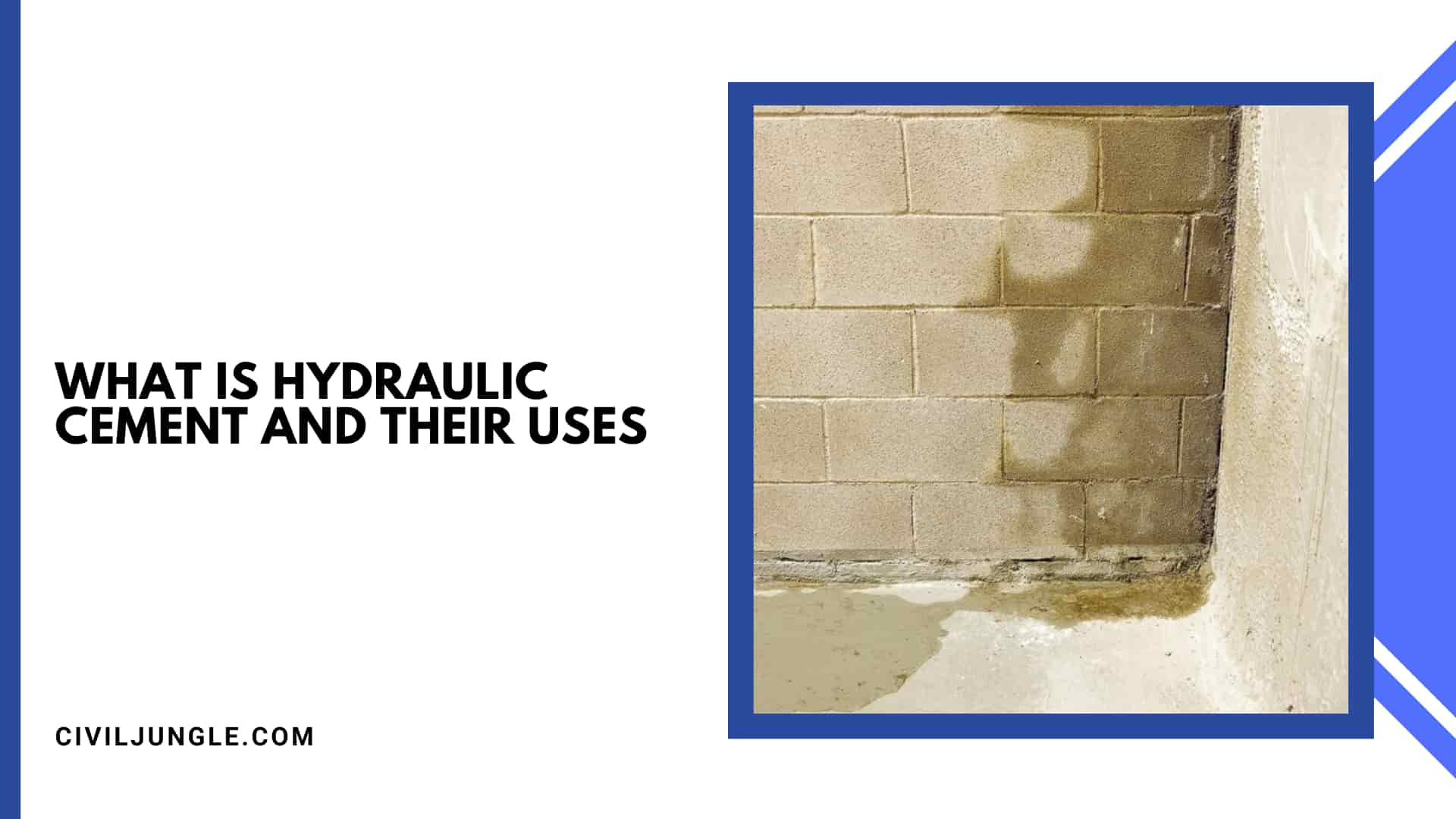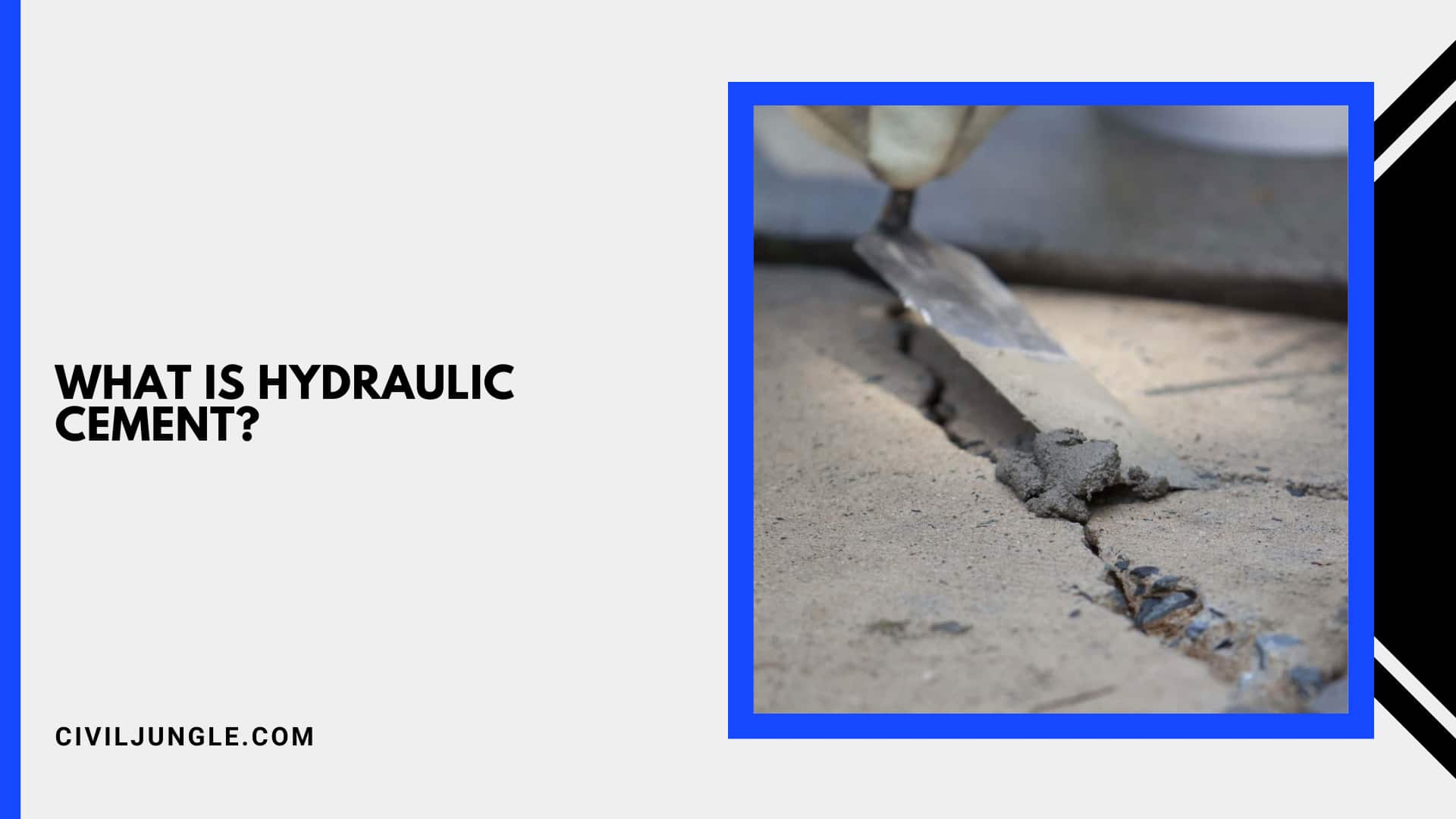Introduction of Hydraulic Cement
Important Point
Hydraulic cement is a type of cement with a special specification. It hardens very quickly with water. Hydraulic Cement is used as mortar to prevent leakage of water in concrete and masonry work.
Hydraulic cement was first used by the Romans in the Middle Ages. Volcanic ash mixed with lime was used as “hydraulic cement” during this time.
Hydraulic cement is a special quality type of cement. Hydraulic cement is used for the construction of structures that are exposed to water.
What Is Hydraulic Cement?
Hydraulic cement is a product made from an inorganic material. Which part of the structure reacts with water? Hydraulic cement is used in special use to close water.
This type of cement has the property of settling quickly when exposed to water. It starts to set in 5-10 minutes after adding water to the hydraulic cement.
The use of hydraulic cement, in general, is increasing due to its special characteristic in the construction industry. Hydraulic cement has special qualities like non-compressible, non-corrosive, and non-rusting.
Hydraulic cement is also used as grouting. The content of hydraulic cement is similar to mortar. It is commonly used for structures that are to be submerged in water.
Chemical Composition of Hydraulic Cement
Four components are mainly used in hydraulic cement,
- Belite (2CaO·SiO2)
- Elite (3CaO·SiO2)
- Tricalcium aluminate/ Celite (3CaO·Al2O3)
- Brownmillerite (4CaO·Al2O3Fe2O3)
The mechanical properties of hydraulic cement are provided by silicate components. While the last two components are added to the kiln for the liquid phase during the manufacturing process.
Some special additive is also required to obtain special properties in hydraulic cement. Additives are added to hydraulic cement to enable changes in the setting time of the cement, to prevent shrinkage for underwater use.
Mixing of Hydraulic Cement
- A mixer machine with a rotary blade should be used to mix the cement to get the right mixture with water.
- The surface to be repaired should be properly saturated before mixing with the mechanical mixer. In addition, the excess water in the mixture should be removed.
- The required water is added to the dry mix as per the specification and instruction as per IS 456: 2000.
- Strength can be obtained by mixing hydraulic cement with suitable water. For hydraulic cement, it is recommended that the cement be mixed according to consumption. Because this mixture should surface within 10-25 minutes.
How Does Hydraulic Cement Work?
- The efficiency of hydraulic cement depends on the process of hydration. When water is added to hydraulic cement, the product starts to harden.
- The components present in hydraulic cement harden very quickly by reactions with water.
- The nature of these chemical components gives hydraulic cement the ability to resist water damage and chemical attacks. Therefore hydraulic cement is used for the construction of submerged structures.
Also Read: What is Plumbing | Plumbing Fixture | Types of Plumbing Fixtures | Water Pipe Sizing Charts
How to Apply Hydraulic Cement?
The surface where hydraulic cement is to be used should be cleaned. Its surface should be free from oil, dirt, grease, or any other contaminants. So as to make a strong connection with the permanent constitution.
The following steps should be followed for the successful application of hydraulic cement.
- The surface for hydraulic cement should be saturated for 24 hours before use.
- The hydraulic cement should be properly mixed with water using a mixer machine to make a uniform mixture.
- The amount of water is added as per the specification of the manufacturer. So that proper strength can be obtained.
- Excess water in the mixture should be removed before using hydraulic cement.
- Now, the right amount of hydraulic cement is applied to the place where the repair work is to be done.
Hydraulic Cement Uses
Here, the uses of hydraulic cement are as follows.
- Tower structures
- Heavy Construction
- Chimneys and sewer pipes
- Footings and foundations
- Levee walls, sea walls, retaining wall
- Dams and breakwaters
- Monolithic concrete houses, concrete block
- Tunnels and prison cells
- Road foundations, paved roads, sidewalks
- Bridges, culverts
- Fireproofing structures
Points to Consider for the Use of Hydraulic Cement
- Hydraulic cement should be mixed in an appropriate quantity as per consumption.
- Excessive water in the mixture of hydraulic cement is likely to cause bleeding and segregation. So that excess water should be removed from the mixture.
- Hydraulic cement should not contain any admixtures or additives other than the manufacturer’s specification.
Advantages of Hydraulic Cement
Here, the pros of hydraulic cement are as follows.
- It is easy to use for any concrete repair.
- Hydraulic cement is set much faster than other cement. In addition, the desired strength can be achieved as early as possible with the use of hydraulic cement.
- This cement has non-shrinkable properties.
- Hydraulic cement can be used as waterproof cement for underwater construction.
- Hydraulic cement gives proper strength for repair work as compared to other cement.
- Hydraulic cement is widely used for concrete repair works in large areas.
- Hydraulic cement can usually be used for the maintenance of basements and other concrete repairs.
Also Read: What to Do If the Concrete Cube Fails After 28 Days?
Disadvantages of Hydraulic Cement
Here, the cons of hydraulic cement are as follows.
- Hydraulic cement begins to harden rapidly through chemical processing with water. So this mixture should be used within 10 to 15 minutes to get its proper strength.
- Hydraulic cement cannot be used for frozen surfaces.
- Hydraulic cement can be reduced in strength if not properly mixed with water.
- Where the temperature is below 48 ° F, the hydraulic cement does not provide sufficient strength. Therefore it cannot be used in such areas.
Conclusion of Hydeaulic Cament
Hydraulic cement is an invention of modern cement, which is used to gain strength underwater and to form a hard surface. Hydraulic cement is used in various places in construction due to its unique properties. Hydraulic cement does not shrink normally.
Like this post? Share it with your friends!
Suggested Read –
- What Is WPC Board?
- Fiberglass RV Roof Replacement
- Types of Beams in Constructions
- What Is a Fiberglass Water Tank?
- What Is Parapet Wall And Their Types
What Is Hydraulic Cement, and How Does It Work?
Hydraulic cement is a type of cement that hardens rapidly when exposed to water. It works by reacting chemically with water, leading to a quick setting process and providing resistance against water damage and chemical attacks.
What Are the Components of Hydraulic Cement?
The main components of hydraulic cement include belite, elite, tricalcium aluminate/celite, and brownmillerite. These components provide the necessary mechanical properties and chemical reactions for hydraulic cement to harden quickly.
What Are the Advantages of Hydraulic Cement?
Hydraulic cement offers several advantages, including rapid setting time (5-10 minutes), non-compressible and non-corrosive properties, resistance to water damage, and suitability for underwater structures.



Leave a Reply